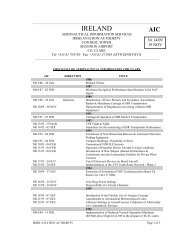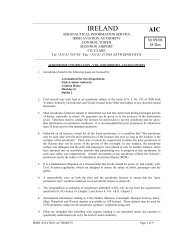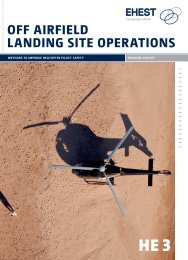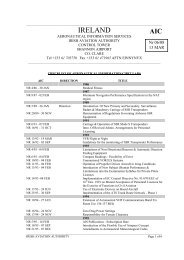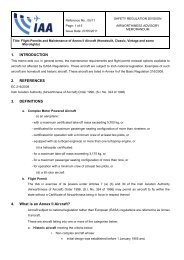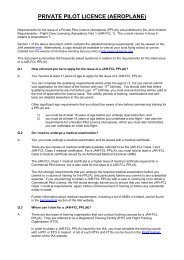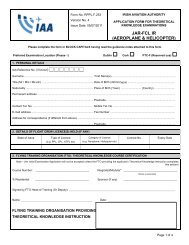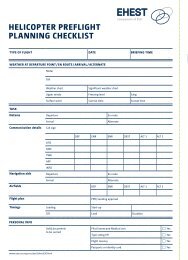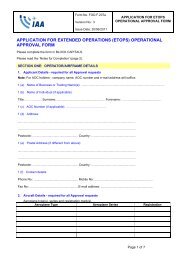Chapter 1 PROVISIONS FOR DANGEROUS GOODS CARRIED BY ...
Chapter 1 PROVISIONS FOR DANGEROUS GOODS CARRIED BY ...
Chapter 1 PROVISIONS FOR DANGEROUS GOODS CARRIED BY ...
- No tags were found...
You also want an ePaper? Increase the reach of your titles
YUMPU automatically turns print PDFs into web optimized ePapers that Google loves.
8-1-2 Part 8stores or other cargo. If the wheelchair or mobility aid cannot be loaded, stowed, secured and unloaded always in anupright position, the battery must be removed and the wheelchair or mobility aid may then be carried as checkedbaggage without restriction. The removed battery must be carried in strong, rigid packagings as follows:1) these packagings must be leak-tight, impervious to battery fluid and be protected against upset by securingthem to pallets or by securing them in cargo compartments using appropriate means of securement (otherthan by bracing with freight or baggage) such as by the use of restraining straps, brackets or holders;2) batteries must be protected against short circuits, secured upright in these packagings andsurrounded by compatible absorbent material sufficient to absorb their total liquid contents; and3) these packagings must be marked “Battery, wet, with wheelchair” or “Battery, wet, with mobility aid”and be labelled with a “Corrosive” label (Figure 5-22) and with a package orientation label (Figure 5-26).The pilot-in-command must be informed of the location of a wheelchair or mobility aid with an installed battery orthe location of a packed battery.It is recommended that passengers make advance arrangements with each operator; also, unless batteries arenon-spillable they should be fitted, where feasible, with spill-resistant vent caps;+ g) with the approval of the operator(s), lithium-ion battery-powered wheelchairs or other similar mobility aidsfor use by passengers whose mobility is restricted by either a disability, their health or age, or a temporary mobilityproblem (e.g. broken leg), subject to the following conditions:1) the batteries must be of a type which meets the requirements of each test in the UN Manual of Tests andCriteria, Part III, section 38.3;2) battery terminals must be protected from short circuits (e.g. by being enclosed within a battery container)and securely attached to the mobility aid;3) the operator(s) must ensure that such mobility aids are carried in a manner so as to preventunintentional activation and that they are protected from being damaged by the movement of baggage, mail,stores or other cargo; and4) the pilot-in-command must be informed of the location of the mobility aid.It is recommended that passengers make advance arrangements with each operator.+ h) with the approval of the operator(s), portable medical electronic devices (Automated ExternalDefibrilators (AED), Nebulizer, Continuous Positive Airway Pressure (CPAP), etc.) containing lithium metal or lithiumion cells or batteries carried by passengers for medical use. No more than two spare batteries may be carried.Spare batteries must be individually protected so as to prevent short circuits (by placement in original retail packagingor by otherwise insulating terminals, e.g. by taping over exposed terminals or placing each battery in a separate plasticbag or protective pouch) and carried in carry-on baggage only. Each installed or spare battery must be of a type whichmeets the requirements of each test in the UN Manual of Tests and Criteria, Part III, section 38.3;In addition, each installed or spare battery must not exceed the following:— for lithium metal batteries, a lithium content of not more than 8 grams; or— for lithium ion batteries, a watt-hour rating of not more than 160 Wh.i) one small medical or clinical thermometer which contains mercury, for personal use, when in its protective case;Articles used in dressing or groomingj) toiletry articles (including aerosols). The total net quantity of each single article must not exceed 0.5 kg or 0.5 L.Release valves on aerosols must be protected by a cap or other suitable means to prevent inadvertent release of thecontents. The term “toiletry articles (including aerosols)” is intended to include such items as hair sprays, perfumes andcolognes.The total net quantity of all articles mentioned in 1.1.2 c), h) and k) must not exceed 2 kg or 2 L (e.g. four aerosol cansof 500 mL each) for each person.k) hair curlers containing hydrocarbon gas, no more than one per person, provided that the safety cover is securelyfitted over the heating element. Gas refills for such curlers must not be carried;Consumer articlesl) when in retail packagings, alcoholic beverages containing more than 24 per cent but not more than 70 per centalcohol by volume, in receptacles not exceeding 5 L, with a total net quantity per person of 5 L for such beverages.2011-2012 EDITION




